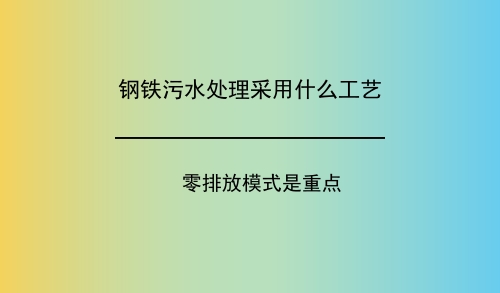What process is used for steel wastewater treatment? Zero emission model is the focus
Classification:
Industry information
Author:
2018/03/29 08:47
[China's smart manufacturing network technology frontier] At present, China is focusing on the treatment of industrial wastewater and waste water. The steel industry, as a high energy-consuming and highly polluting industry, has always been concerned about its wastewater treatment. In the key stage of “green transformation”, what kind of process is used in the sewage system of the steel industry, the treatment of high salty wastewater in desalination stations and softening stations, and the wastewater treatment in the production process?

What process is used for steel wastewater treatment? Zero emission model is the focus
As a pillar industry of the country, the iron and steel industry has caused difficulties for steel companies due to a series of problems such as overcapacity, regional layout, irrational industrial structure, and serious environmental pollution. At the same time, the steel industry has also pushed the steel industry to “decapacity” and “green transformation”. The new stage.
In March 2017, the Ministry of Environmental Protection had already proposed in the 2017 Work Plan for Prevention and Control of Atmospheric Pollution in the Beijing-Tianjin-Hebei Region and the Peripheral Regions, requiring all steel and coal to be used in the “2+26” urban administrative area before September 2017. Boiler emissions of sulfur dioxide, nitrogen oxides and particulate air pollutants implement national special emission limits. Therefore, ultra-low emission control of flue gas in the non-electrical fields such as steel has become an important area following the ultra-low emission of coal-fired flue gas. Recently, the Hebei Provincial Department of Environmental Protection stated that Hebei will implement a comprehensive emission standard for industrial enterprises in 2018, and implement ultra-low emission reforms for key industries such as steel and coking. In addition to exhaust gas, the discharge of steel wastewater is also a major concern.
Wastewater from iron and steel enterprises can be roughly divided into sources such as the drainage of process water or equipment cooling circulating water systems, high salt-containing wastewater discharged from desalination stations and softening stations, and wastewater generated during the production process.
Circulating water system sewage
The form of water used by iron and steel enterprises is mainly equipment cooling water. Among them, indirect cooling water is only heated and contaminated during use, and can be reused after cooling. Direct cooling water is directly contacted with product materials and contains contaminated substances, and must be treated before being reused or cascaded.
Highly salty wastewater from desalination stations and softening stations
The closed cooling water system make-up water and boiler water all belong to desalinated water or demineralized water, generally prepared by desalting station or softening station. The main process principle of salt removal is the separation of the water quality of ions in the water, and the corresponding equipment such as electrodialysis, ion exchange, membrane, etc. Finally, the salt ions in the raw water are separated to obtain salt water and demineralized water, and the remaining high salt water is passed. The separate pipe network is partially used for steelmaking slag, ironmaking slag, etc.
Wastewater from the production process
General iron and steel enterprises produce waste water in the production process of sintering pellets, coking, ironmaking, steelmaking, hot rolling, and cold rolling. The main waste water is conveyor belt cleaning, floor washing, and wet dust removal. This is general production wastewater. . In addition, iron and steel enterprises will also produce various kinds of special waste water, and the pollution is more serious, mainly coking phenol cyanide wastewater, cold-rolled chromium-containing waste water and so on.
The main components of wastewater used in general production are particulates, inorganic salts, and other pollutants. Physical treatment is mainly used to remove SS, hardness, and other pollutants from the water. Some of the wastewater can also be subjected to deep desalination measures, and inorganic salts can be further removed to improve water quality. Comprehensive wastewater reuse rate.
Phenol cyanide wastewater treatment generally uses A-A-O internal circulation biological denitrification process. Wastewater is firstly conditioned, deoiled, floated, diluted, and then sent to a biological treatment system to remove pollutants such as COD, phenol, cyanide, ammonia nitrogen, etc., and finally to remove wastewater by coagulation and sedimentation. Medium COD and SS. After the treatment, the effluent cascade is used for blast furnace slag flushing or converter slag system replenishment.
After the cold-rolled chromium-containing waste water is reduced and neutralized, it is then clarified by a high-efficiency clarifier and filtered by a filter. It is used in a separate treatment of the desalination station and used for slag blasting and converter slag in the blast furnace.
However, in the era when low-carbon economic development models are valued, the prevention and control of water pollution and the conservation of water resources are also important issues faced by the steel industry. How to achieve zero discharge of wastewater is the current goal pursued by steel companies.
The zero discharge of waste water from the iron and steel industry mainly refers to the repeated use of waste water generated by the plant itself, thereby realizing the reduction and recycling of waste water and realizing no waste water from the whole plant. At present, many steel companies have tried to implement a zero discharge model for wastewater.
According to reports, the Rizhao Iron and Steel Plant of Shanshan Iron and Steel Co., Ltd. adopts dry quenching, dry dedusting of blast furnace gas, and dry-cleaning method of converter gas to remove water from the source. At the same time, seawater replaces a lot of new water. The cascade utilization technology of "different quality water supply and cascade utilization" has realized the rational cascade utilization of net water and turbid water.
At the same time, in the aspect of waste water, industrial waste water is treated with conditioning tank + high-efficiency clarifier tank + homogeneous filter filter water treatment process, and ultrafiltration reverse osmosis process is used for advanced treatment. Product water is used as softened water, demineralized water and miscellaneous water; The brine is reprocessed for further reduction, and eventually the concentrated brine is expendable by the production process. The sewage treatment uses the A/O process. The decentralized biochemical station biochemically treats the domestic sewage of the whole plant. The biochemically treated sewage is sent to the high-efficiency clarifier tank of the industrial sewage treatment station through the pump unit, and is treated together with the industrial sewage for advanced treatment.
Original title: Wastewater Treatment Process and Zero Emissions Technology in the Iron and Steel Industry
Article link: China Intelligent Manufacturing Network http://www.gkzhan.com/news/detail/108641.html
Key words:
[State Council Policy] How the reform can make innovation run out of "acceleration"——The Party Secretary of the Ministry of Science and Technology Wang Zhigang authoritatively interprets the construction of a scientific and technological power
2018-03-29
What process is used for steel wastewater treatment? Zero emission model is the focus
2018-03-29
Researcher Develops 3D Printing Bionic Super Hydrophobic Structure for Oil-water Separation
2018-03-29
Development of smart manufacturing solutions
2018-03-29
Related news


